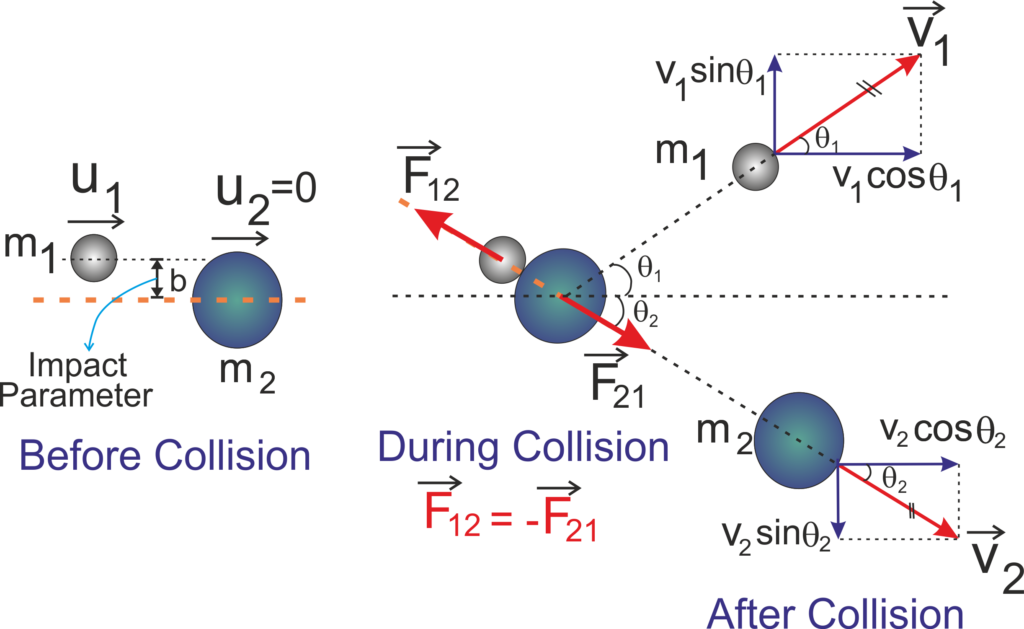Collision of Bodies
COLLISION
When two bodies (or particles), either physically strike against each other or if the path of the motion of one is influenced by the other, Collision is said to occur between the two bodies.
For a collision it is not necessary that the bodies are actually coming in contact. Only condition is that they must apply force on each other such that their motion changes suddenly.
When two bodies collide, they exert interacting forces on each other. These interacting forces are always equal and opposite (Newton’s 3rd Law). So, if we consider the two bodies together as a system, total linear momentum of the system must remain conserved in every type of collision.
There are two types collision:
Elastic Collision:
The type of collision in which total Kinetic energy of the system of bodies remain same before and after collision, it is known as elastic collision.
So, in case of elastic collision total momentum and the total kinetic energy of the system (the two bodies together) remain constant.
- In case of elastic collision all the interacting forces acting between the two bodies are conservative in nature.
- The collisions between the atomic, nuclear and fundamental particles are elastic collisions.
Inelastic Collision:
The type of collision in which total Kinetic energy of the system of bodies doesn’t remain same before and after collision, it is known as inelastic collision.
So, in case of inelastic collision only the total momentum of the system (the two bodies together) remains constant.
- Most of the collisions occurring between two bodies around us are examples of inelastic collision.
One dimensional collision or Head – on collision
When two particles that make collision move such that before and after collision their center of mass move on the same straight line, it is called one – dimensional collision or head on collision.

During collision the two bodies apply force on each other according to Newton’s third law and
.
If we consider both the bodies together as a system, the net external force on the system is zero. So, according to principle of conservation of momentum.
Pi = Pf
m1u1 + m2u2 = m1v1 + m2v2 — (i)
This equation is valid for every type of one-dimensional collision.
Elastic collision in one Dimension or Head on elastic collision
In case of elastic collision the total Kinetic energy of the system remains conserved i.e. for elastic collision total Kinetic energy of the system of bodies before collision remains same as its value after collision. So,
Ki = Kf
½ m1u12 + ½ m2u22 = ½ m1v12 + ½ m2v22 ———- (ii)
By (i) m1 (u1 – v1) = m2 (v2 – u2) ———- (iii)
Similarly by (ii) m1u12 – m1v12 = m2v22 – m2u22
m1 (u12 – v12) = m2 (v22 – u22) ———- (iv)
By (iv) / (iii)
(u1 + v1) = (v2 + u2)
u1 – u2 = v2 – v1 —-— (v)
In case of elastic collision in one dimension the velocity of approach before collision is equal to the velocity of separation of the bodies after collision.
by eq. (v). v2 = u1 – u2 + v1
Putting the value of v2 in eq. (i)
m1u1 + m2u2 = m1v1 + m2 (u1 – u2 + v1)
m1u1 + m2u2 = m1v1 + m2u1 – m2u2 + m2v1
m1u1 + m2u2 = (m1+m2) v1 + m2 (u1-u2)
(m1 – m2) u1 + 2m2u2 = (m1 + m2) v1
Or
Again by (v), v1 = v2 – u1 + u2
Putting the value of v1 in eq. (i)
m1u1 + m2u2 = m1 (v2 – u1 + u2) + m2v2
m1u1 + m2u2 = m1v2 – m1u1 + m1v2 + m2v2
m1u1 + m2u2 = – m1u1 + m1u2 + (m1 + m2) v2
2m1u1 + (m2 – m1) u2 = (m1 + m2) v2
Special Case:
Case 1.
If both the bodies are of same mass
i.e. if m1 = m2 = m (let)
By eq. (vi)
Or, v1 = u2
And, by eq. (vii)
Or, v2 = u1
The bodies exchange their velocities after collision if the bodies of same mass make elastic collision in one dimension.
Case 2.
If the bodies are of same mass and the second body is initially at rest.
i.e. if m1 = m2 = m (let); u2 = 0
by eq. (vi)
Or, v1 = 0
by eq. (vii)
Or, v2 = u1
In this case the first body will come to rest and the second body will move with velocity of first body after collision.
Inelastic collision in one Dimension or Head on Inelastic collision:
When the kinetic energy of the system doesn’t remains conserved, the collision is called inelastic collision.
In case of inelastic collision there is loss in energy.
The loss in energy is
ΔK = Kf – Ki
ΔK = (½ m1v12 + ½m1v22) – (½m1v12 + ½m2u22) ……….(viii)
Perfectly Inelastic Collision in One Dimension:
If after collision the two bodies stick to each other and move together after collision, then it is called perfectly inelastic collision.
In this case v1 = v2 = V (let)
By eq. (i), we get m1u1 + m2u2 = m1V + m2V
m1u1 + m2u2 = V (m1 + m2)
Or,
Two Dimensional Collision or Oblique Collision
When the center of mass of the colliding bodies move in different directions in a plane before or after the collision, it is called two dimensional collision or oblique collision.
During oblique collision the two bodies apply interacting force on each other such that the direction of these forces is normal to the surfaces in contact. So, direction of the interacting forces is different than their original direction of motion. As a result after the collision the two bodies move in different directions [let at angle θ1 and θ2] with velocities and
. If we consider the two bodies together as a system, there is no external force so, the total momentum of the system remains conserved.

along x – axis
Pix = Pfx
m1u1 + 0 = m1v1 cosθ1 + m2v2 cosθ2
Or, m1u1 = m1v1 cosθ1 + m2v2 cosθ2 — (xi)
Along y – axis
Piy = Pfy
0 = m1v1sinθ1 + m2v2sinθ2 —— (xii)
In case of elastic collision the total kinetic energy remains conserved
i.e. Ki = Kf

